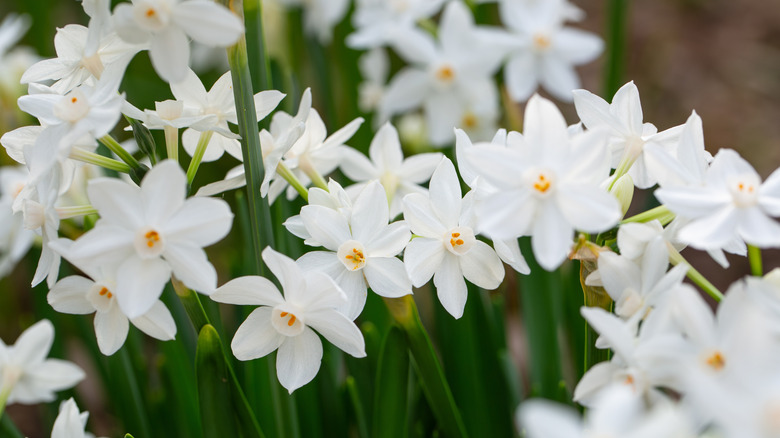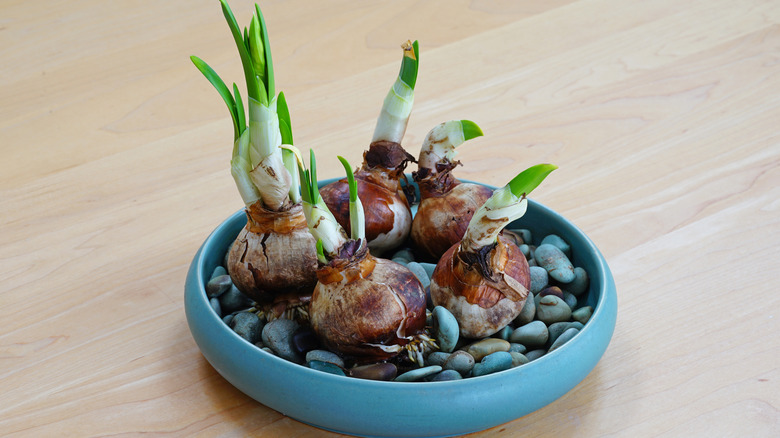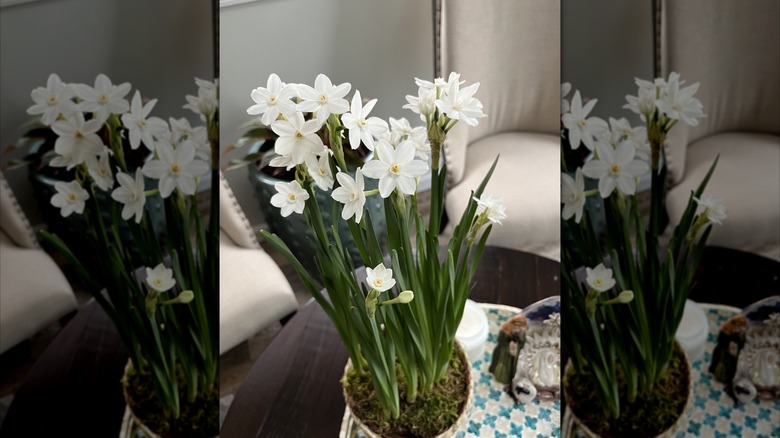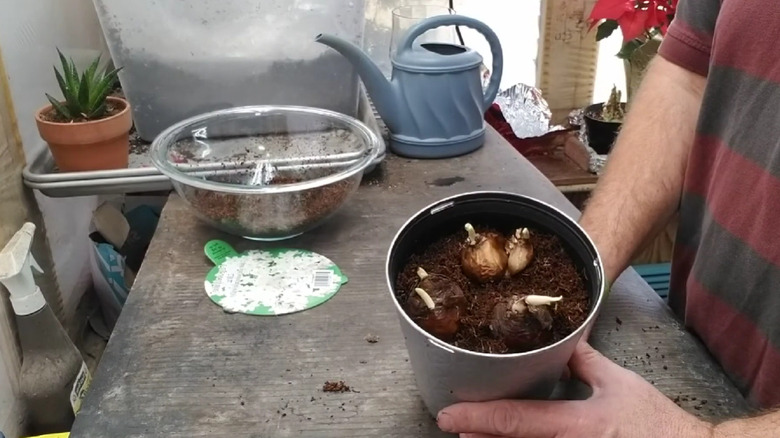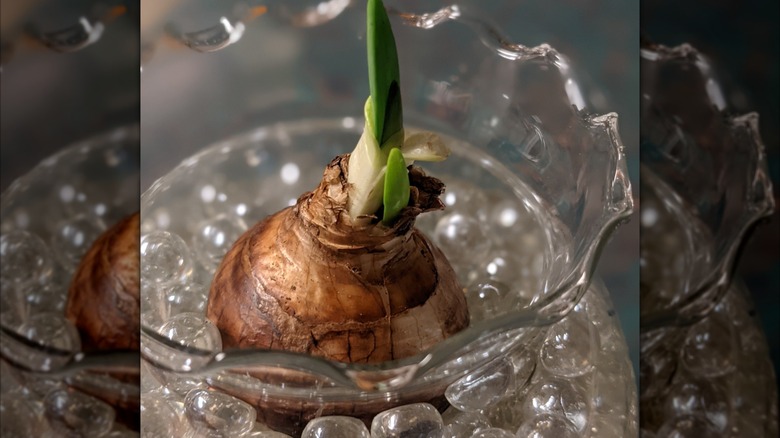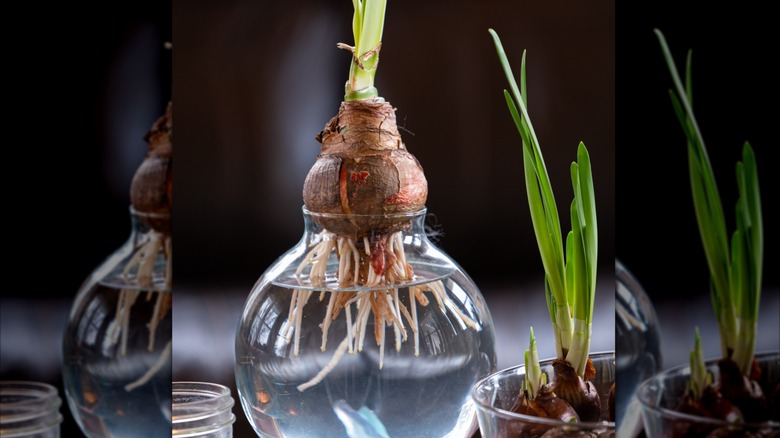7 Ways To Plant Paperwhites Indoors Without Using Soil
When we head into the gloomier winter weather months, it's easy to forget about all the things we associate with warmer weather — like blooming flowers. And yet growing paperwhites (Narcissus tazetta) is one of the simplest ways to bring freshness and fragrance into the home when your outdoor garden is taking its winter rest. As members of the daffodil family, paperwhites require no chilling period (unlike most spring bulbs), which makes them a particularly good choice for indoor forcing — a method that quickens the bulb's development and effectively tricks it into thinking it's early springtime and time to grow. If you plant these flowers in November, you'll have stunning blooms by Christmas!
With some water, light, and a support structure, paperwhites will bloom in as little as three to five weeks. That's right — while these fragrant blooms can be grown traditionally in potting soil, they thrive just as well in a variety of other media, like glass beads, crushed glass, sand, stones, and even in plain water if you use the right container. Their crisp white flowers and delicious scent make them a seasonal favorite for indoor home decor. Because they can grow so rapidly (sometimes upwards of 16 inches in height), paperwhites are great for staggered displays throughout the winter and early spring. Don't be afraid to get creative with these flowers, whether it's planting them in stones for a windowsill display or using moss for a thoughtful homemade gift.
Stones in a vase or planter
Large sculptural stones are the perfect way to grow paperwhites in wider bowls or tall vases without soil, as they provide the flowers with good structure to hold them in place. Fill your container with a couple of inches of chunkier stones, then position your bulbs between them. Then, add just enough water to moisten the underside, never submerge, to allow the roots to anchor themselves. Place your bulbs in a bright place, maintain the water level, and in a few weeks, you'll begin seeing those characteristic vibrant green stems.
Sand and moss
If you're worried about your paperwhites getting too tall and flopping over when grown with only stones to anchor them, try using sand as a base in lieu of soil. Coarse sand provides the packed structure of potting soil, but doesn't risk waterlogging. Place your bulbs in the sand, leaving their pointed tip above the surface, then water. To some, sand may not provide all the aesthetic benefits of other suggestions on this list, though, so gently pack some decorative moss on top of the exposed sand for an organic, yet festive display for the winter.
Coco peat in a planter
If you want the structure of growing paperwhites in soil but with a healthier alternative, look for a mix composed primarily of coco peat, aka coco coir– a material that allows the plant to maintain good moisture without the risk of waterlogging. As we've mentioned, paperwhites don't need to be completely bogged down with lots of water; in fact, that could accidentally drown the bulbs or make them susceptible to bulb rot. Implement this must-know tip to prevent paperwhite root rot, and you'll have some delicious daffodil-like blooms growing in coco coir.
Marbles in a vase
Following the same concept as the larger stones, growing paperwhites in glass marbles can create crisp displays of wintertime blossoms. It looks clean and modern, and at the same time, it's a practical method to easily monitor your paperwhite's root system. Fill your vessel halfway with the marbles, then firmly set your bulbs so that they won't tip. Add water to the bottom of the vase, then watch your paperwhites grow! If you want to switch it up, try colored glass beads or marbles for a festive edge.
Water in an narrow-necked vessel
If you like the idea of growing paperwhites in nothing but water, you'll need a particular vessel to grow them successfully. Specifically, one with a skinny neck and a wide base that allows the bulb to dip its roots into water without falling in. First, fill the container with water to the height where it just reaches the base of the bulb. Place the bulb on top, then keep it in a darker location until the green shoots begin to sprout. Finally, move the plant to a sunnier, room-temperature spot to enjoy its blooms.
Broken glass in a clear vase
A creative way to reuse broken glass in your home and garden is to turn the otherwise-thought-trash into the perfect base for forced paperwhite growth. While traditional methods suggest using manufactured rock glass, recycling glass at home (particularly if crushed safely) will achieve the same results. The process to plant is nearly the same as for glass marbles — fill the bottom of the vessel with a couple of inches of crushed glass, then nestle the bulbs so they sit firmly in it. Finally, add water until it reaches the base of the bulbs.
Aquarium gravel in a vase
A daintier alternative to larger stones, aquarium gravel is a favorite among gardeners because of its versatility — you can use it in smaller containers, and it won't look out of place, unlike pea gravel or driveway gravel that can still look too oversized in certain situations. For this base, fill your vase or planter halfway up with the pebbles, then add water until it reaches the top of the gravel line. Arrange your bulbs on the gravel, then add more pebbles in the negative space for a little extra anchor.
